International Human Resource Management: Cultural Differences and Challenges Faced by Australian Technology Organization
VerifiedAdded on 2023/06/12
|13
|2958
|193
AI Summary
This report discusses the cultural issues faced by an Australian technology organization while expanding its business internationally. It highlights the issues faced by the organization and relates them to Hofstede's cultural dimensions. The report provides recommendations to mitigate these issues.
Contribute Materials
Your contribution can guide someone’s learning journey. Share your
documents today.
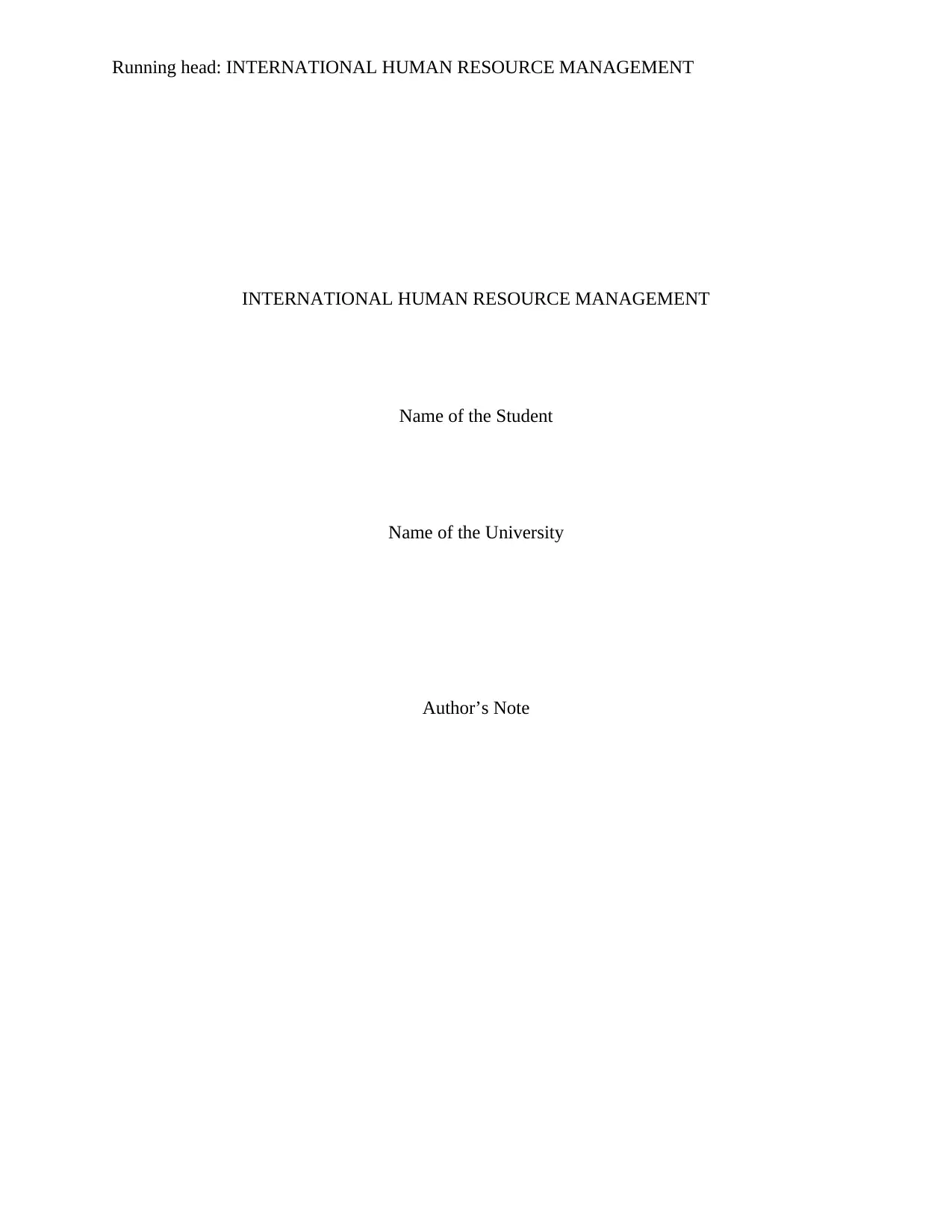
Running head: INTERNATIONAL HUMAN RESOURCE MANAGEMENT
INTERNATIONAL HUMAN RESOURCE MANAGEMENT
Name of the Student
Name of the University
Author’s Note
INTERNATIONAL HUMAN RESOURCE MANAGEMENT
Name of the Student
Name of the University
Author’s Note
Secure Best Marks with AI Grader
Need help grading? Try our AI Grader for instant feedback on your assignments.
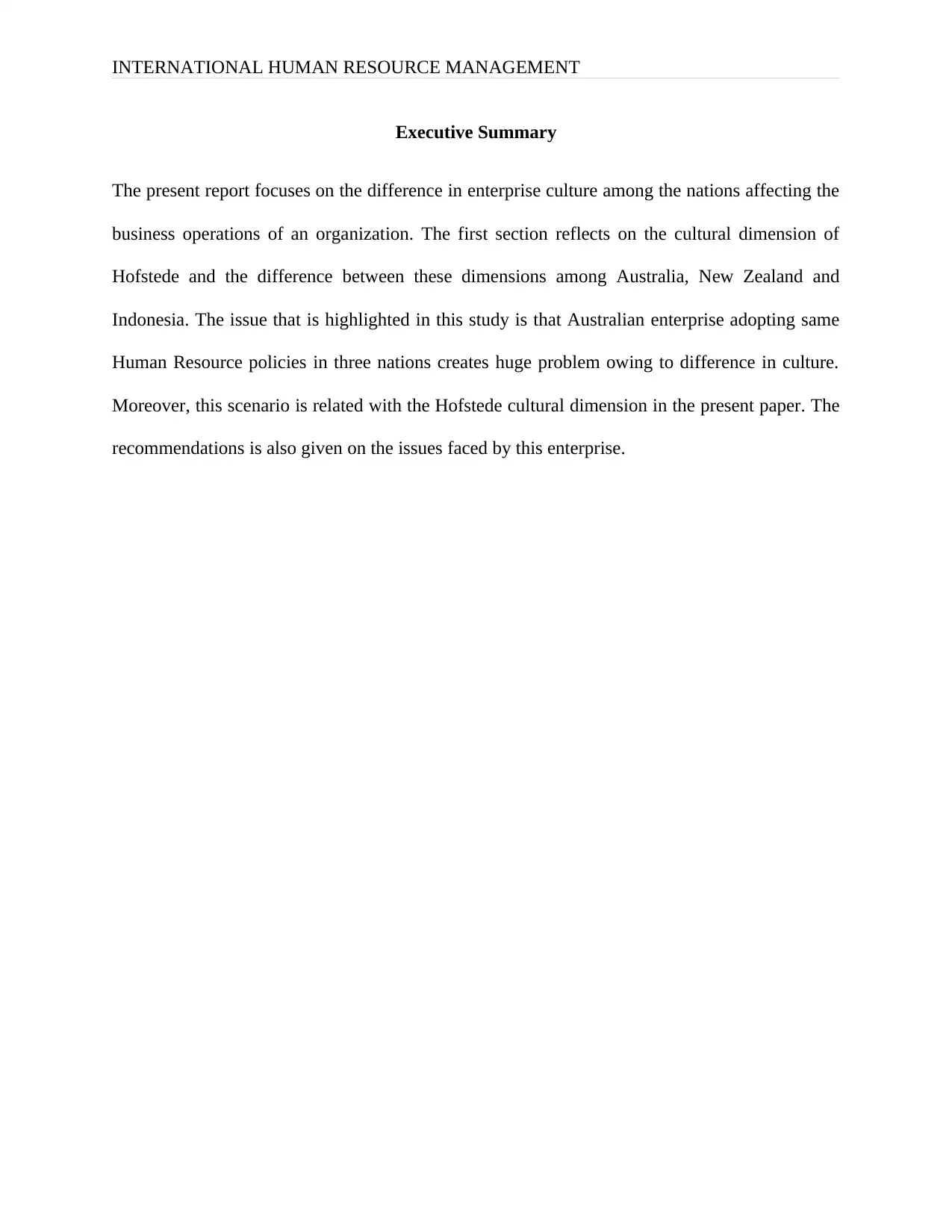
INTERNATIONAL HUMAN RESOURCE MANAGEMENT e
Executive Summary
The present report focuses on the difference in enterprise culture among the nations affecting the
business operations of an organization. The first section reflects on the cultural dimension of
Hofstede and the difference between these dimensions among Australia, New Zealand and
Indonesia. The issue that is highlighted in this study is that Australian enterprise adopting same
Human Resource policies in three nations creates huge problem owing to difference in culture.
Moreover, this scenario is related with the Hofstede cultural dimension in the present paper. The
recommendations is also given on the issues faced by this enterprise.
Executive Summary
The present report focuses on the difference in enterprise culture among the nations affecting the
business operations of an organization. The first section reflects on the cultural dimension of
Hofstede and the difference between these dimensions among Australia, New Zealand and
Indonesia. The issue that is highlighted in this study is that Australian enterprise adopting same
Human Resource policies in three nations creates huge problem owing to difference in culture.
Moreover, this scenario is related with the Hofstede cultural dimension in the present paper. The
recommendations is also given on the issues faced by this enterprise.
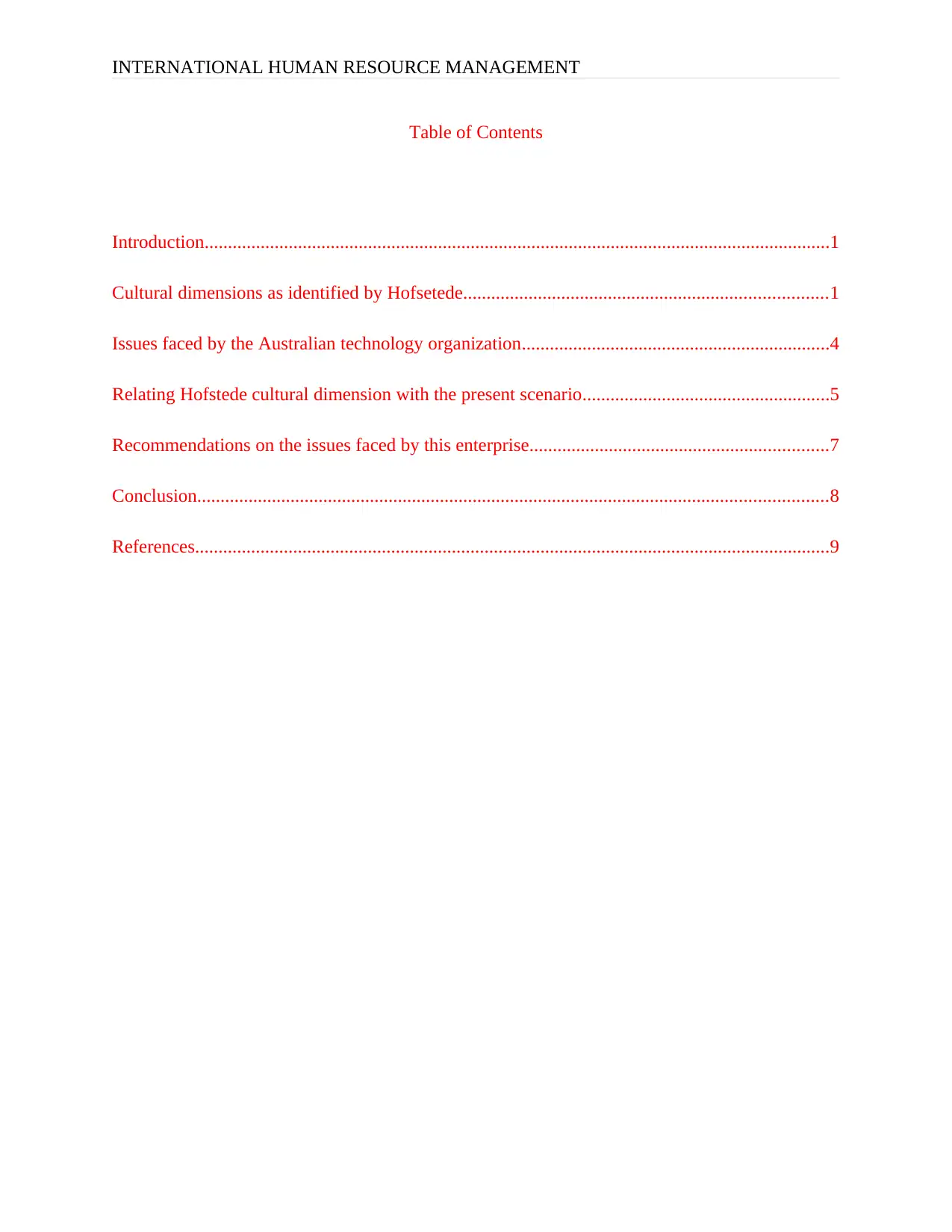
INTERNATIONAL HUMAN RESOURCE MANAGEMENT e
Table of Contents
Introduction......................................................................................................................................1
Cultural dimensions as identified by Hofsetede..............................................................................1
Issues faced by the Australian technology organization..................................................................4
Relating Hofstede cultural dimension with the present scenario.....................................................5
Recommendations on the issues faced by this enterprise................................................................7
Conclusion.......................................................................................................................................8
References........................................................................................................................................9
Table of Contents
Introduction......................................................................................................................................1
Cultural dimensions as identified by Hofsetede..............................................................................1
Issues faced by the Australian technology organization..................................................................4
Relating Hofstede cultural dimension with the present scenario.....................................................5
Recommendations on the issues faced by this enterprise................................................................7
Conclusion.......................................................................................................................................8
References........................................................................................................................................9
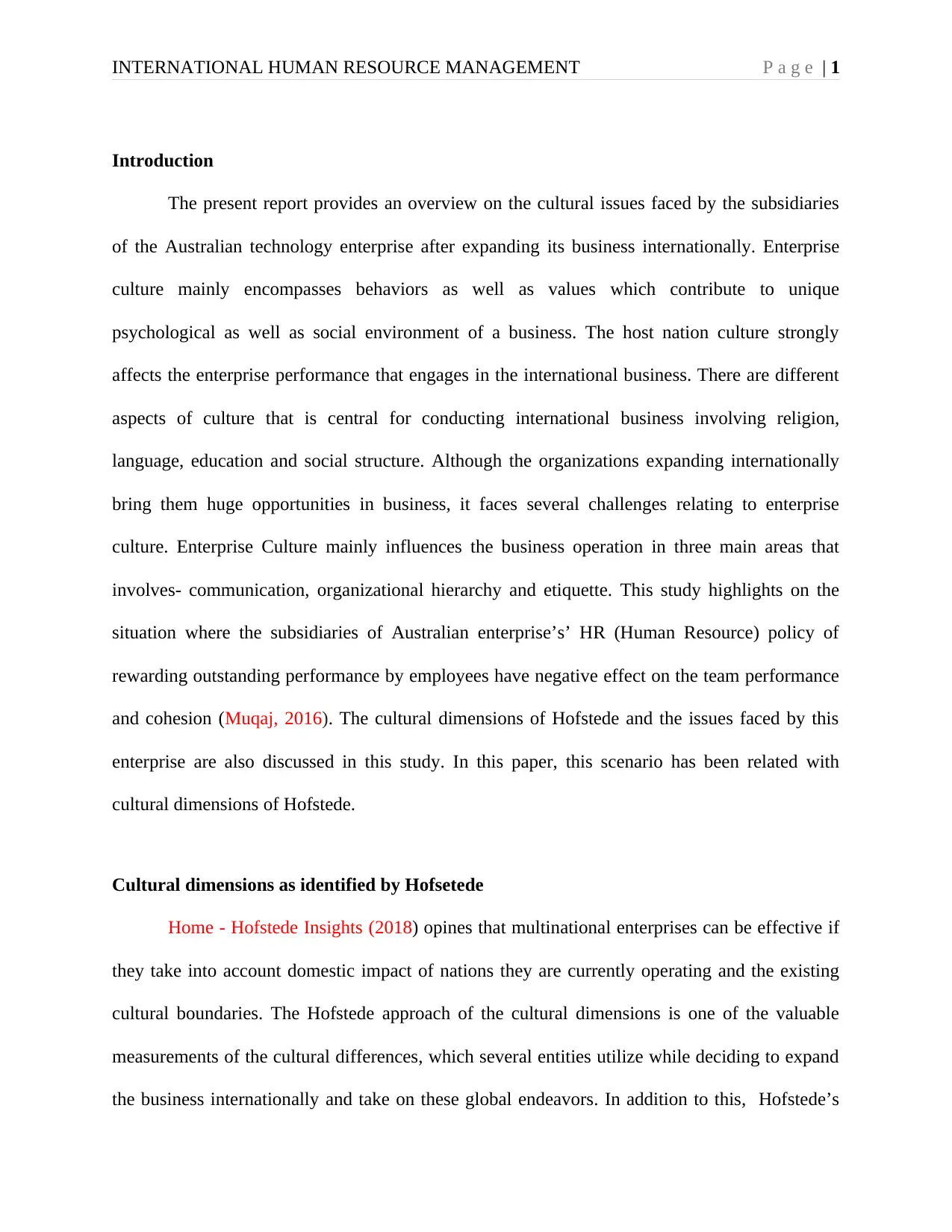
INTERNATIONAL HUMAN RESOURCE MANAGEMENT P a g e | 1
Introduction
The present report provides an overview on the cultural issues faced by the subsidiaries
of the Australian technology enterprise after expanding its business internationally. Enterprise
culture mainly encompasses behaviors as well as values which contribute to unique
psychological as well as social environment of a business. The host nation culture strongly
affects the enterprise performance that engages in the international business. There are different
aspects of culture that is central for conducting international business involving religion,
language, education and social structure. Although the organizations expanding internationally
bring them huge opportunities in business, it faces several challenges relating to enterprise
culture. Enterprise Culture mainly influences the business operation in three main areas that
involves- communication, organizational hierarchy and etiquette. This study highlights on the
situation where the subsidiaries of Australian enterprise’s’ HR (Human Resource) policy of
rewarding outstanding performance by employees have negative effect on the team performance
and cohesion (Muqaj, 2016). The cultural dimensions of Hofstede and the issues faced by this
enterprise are also discussed in this study. In this paper, this scenario has been related with
cultural dimensions of Hofstede.
Cultural dimensions as identified by Hofsetede
Home - Hofstede Insights (2018) opines that multinational enterprises can be effective if
they take into account domestic impact of nations they are currently operating and the existing
cultural boundaries. The Hofstede approach of the cultural dimensions is one of the valuable
measurements of the cultural differences, which several entities utilize while deciding to expand
the business internationally and take on these global endeavors. In addition to this, Hofstede’s
Introduction
The present report provides an overview on the cultural issues faced by the subsidiaries
of the Australian technology enterprise after expanding its business internationally. Enterprise
culture mainly encompasses behaviors as well as values which contribute to unique
psychological as well as social environment of a business. The host nation culture strongly
affects the enterprise performance that engages in the international business. There are different
aspects of culture that is central for conducting international business involving religion,
language, education and social structure. Although the organizations expanding internationally
bring them huge opportunities in business, it faces several challenges relating to enterprise
culture. Enterprise Culture mainly influences the business operation in three main areas that
involves- communication, organizational hierarchy and etiquette. This study highlights on the
situation where the subsidiaries of Australian enterprise’s’ HR (Human Resource) policy of
rewarding outstanding performance by employees have negative effect on the team performance
and cohesion (Muqaj, 2016). The cultural dimensions of Hofstede and the issues faced by this
enterprise are also discussed in this study. In this paper, this scenario has been related with
cultural dimensions of Hofstede.
Cultural dimensions as identified by Hofsetede
Home - Hofstede Insights (2018) opines that multinational enterprises can be effective if
they take into account domestic impact of nations they are currently operating and the existing
cultural boundaries. The Hofstede approach of the cultural dimensions is one of the valuable
measurements of the cultural differences, which several entities utilize while deciding to expand
the business internationally and take on these global endeavors. In addition to this, Hofstede’s
Secure Best Marks with AI Grader
Need help grading? Try our AI Grader for instant feedback on your assignments.
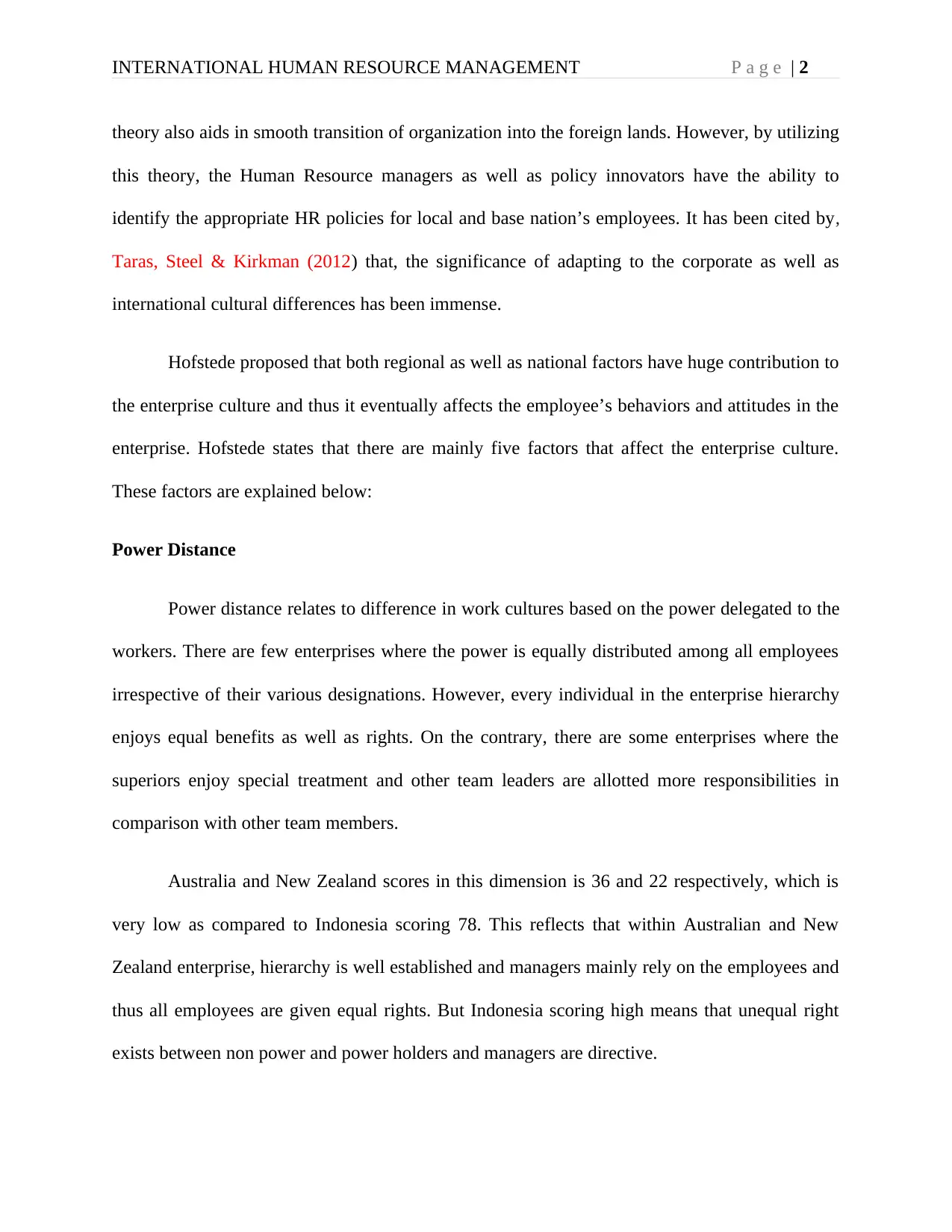
INTERNATIONAL HUMAN RESOURCE MANAGEMENT P a g e | 2 e
theory also aids in smooth transition of organization into the foreign lands. However, by utilizing
this theory, the Human Resource managers as well as policy innovators have the ability to
identify the appropriate HR policies for local and base nation’s employees. It has been cited by,
Taras, Steel & Kirkman (2012) that, the significance of adapting to the corporate as well as
international cultural differences has been immense.
Hofstede proposed that both regional as well as national factors have huge contribution to
the enterprise culture and thus it eventually affects the employee’s behaviors and attitudes in the
enterprise. Hofstede states that there are mainly five factors that affect the enterprise culture.
These factors are explained below:
Power Distance
Power distance relates to difference in work cultures based on the power delegated to the
workers. There are few enterprises where the power is equally distributed among all employees
irrespective of their various designations. However, every individual in the enterprise hierarchy
enjoys equal benefits as well as rights. On the contrary, there are some enterprises where the
superiors enjoy special treatment and other team leaders are allotted more responsibilities in
comparison with other team members.
Australia and New Zealand scores in this dimension is 36 and 22 respectively, which is
very low as compared to Indonesia scoring 78. This reflects that within Australian and New
Zealand enterprise, hierarchy is well established and managers mainly rely on the employees and
thus all employees are given equal rights. But Indonesia scoring high means that unequal right
exists between non power and power holders and managers are directive.
theory also aids in smooth transition of organization into the foreign lands. However, by utilizing
this theory, the Human Resource managers as well as policy innovators have the ability to
identify the appropriate HR policies for local and base nation’s employees. It has been cited by,
Taras, Steel & Kirkman (2012) that, the significance of adapting to the corporate as well as
international cultural differences has been immense.
Hofstede proposed that both regional as well as national factors have huge contribution to
the enterprise culture and thus it eventually affects the employee’s behaviors and attitudes in the
enterprise. Hofstede states that there are mainly five factors that affect the enterprise culture.
These factors are explained below:
Power Distance
Power distance relates to difference in work cultures based on the power delegated to the
workers. There are few enterprises where the power is equally distributed among all employees
irrespective of their various designations. However, every individual in the enterprise hierarchy
enjoys equal benefits as well as rights. On the contrary, there are some enterprises where the
superiors enjoy special treatment and other team leaders are allotted more responsibilities in
comparison with other team members.
Australia and New Zealand scores in this dimension is 36 and 22 respectively, which is
very low as compared to Indonesia scoring 78. This reflects that within Australian and New
Zealand enterprise, hierarchy is well established and managers mainly rely on the employees and
thus all employees are given equal rights. But Indonesia scoring high means that unequal right
exists between non power and power holders and managers are directive.
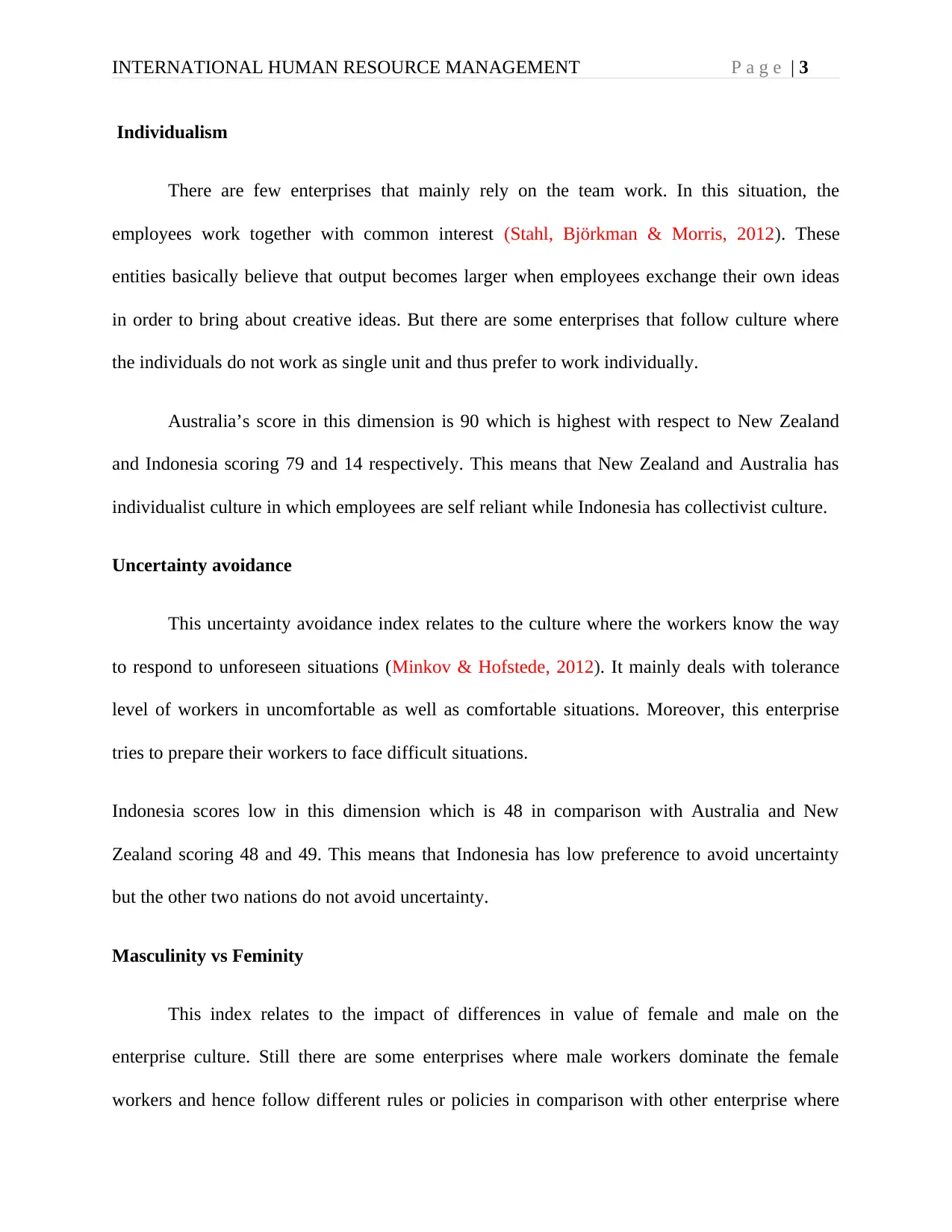
INTERNATIONAL HUMAN RESOURCE MANAGEMENT P a g e | 3 e
Individualism
There are few enterprises that mainly rely on the team work. In this situation, the
employees work together with common interest (Stahl, Björkman & Morris, 2012). These
entities basically believe that output becomes larger when employees exchange their own ideas
in order to bring about creative ideas. But there are some enterprises that follow culture where
the individuals do not work as single unit and thus prefer to work individually.
Australia’s score in this dimension is 90 which is highest with respect to New Zealand
and Indonesia scoring 79 and 14 respectively. This means that New Zealand and Australia has
individualist culture in which employees are self reliant while Indonesia has collectivist culture.
Uncertainty avoidance
This uncertainty avoidance index relates to the culture where the workers know the way
to respond to unforeseen situations (Minkov & Hofstede, 2012). It mainly deals with tolerance
level of workers in uncomfortable as well as comfortable situations. Moreover, this enterprise
tries to prepare their workers to face difficult situations.
Indonesia scores low in this dimension which is 48 in comparison with Australia and New
Zealand scoring 48 and 49. This means that Indonesia has low preference to avoid uncertainty
but the other two nations do not avoid uncertainty.
Masculinity vs Feminity
This index relates to the impact of differences in value of female and male on the
enterprise culture. Still there are some enterprises where male workers dominate the female
workers and hence follow different rules or policies in comparison with other enterprise where
Individualism
There are few enterprises that mainly rely on the team work. In this situation, the
employees work together with common interest (Stahl, Björkman & Morris, 2012). These
entities basically believe that output becomes larger when employees exchange their own ideas
in order to bring about creative ideas. But there are some enterprises that follow culture where
the individuals do not work as single unit and thus prefer to work individually.
Australia’s score in this dimension is 90 which is highest with respect to New Zealand
and Indonesia scoring 79 and 14 respectively. This means that New Zealand and Australia has
individualist culture in which employees are self reliant while Indonesia has collectivist culture.
Uncertainty avoidance
This uncertainty avoidance index relates to the culture where the workers know the way
to respond to unforeseen situations (Minkov & Hofstede, 2012). It mainly deals with tolerance
level of workers in uncomfortable as well as comfortable situations. Moreover, this enterprise
tries to prepare their workers to face difficult situations.
Indonesia scores low in this dimension which is 48 in comparison with Australia and New
Zealand scoring 48 and 49. This means that Indonesia has low preference to avoid uncertainty
but the other two nations do not avoid uncertainty.
Masculinity vs Feminity
This index relates to the impact of differences in value of female and male on the
enterprise culture. Still there are some enterprises where male workers dominate the female
workers and hence follow different rules or policies in comparison with other enterprise where
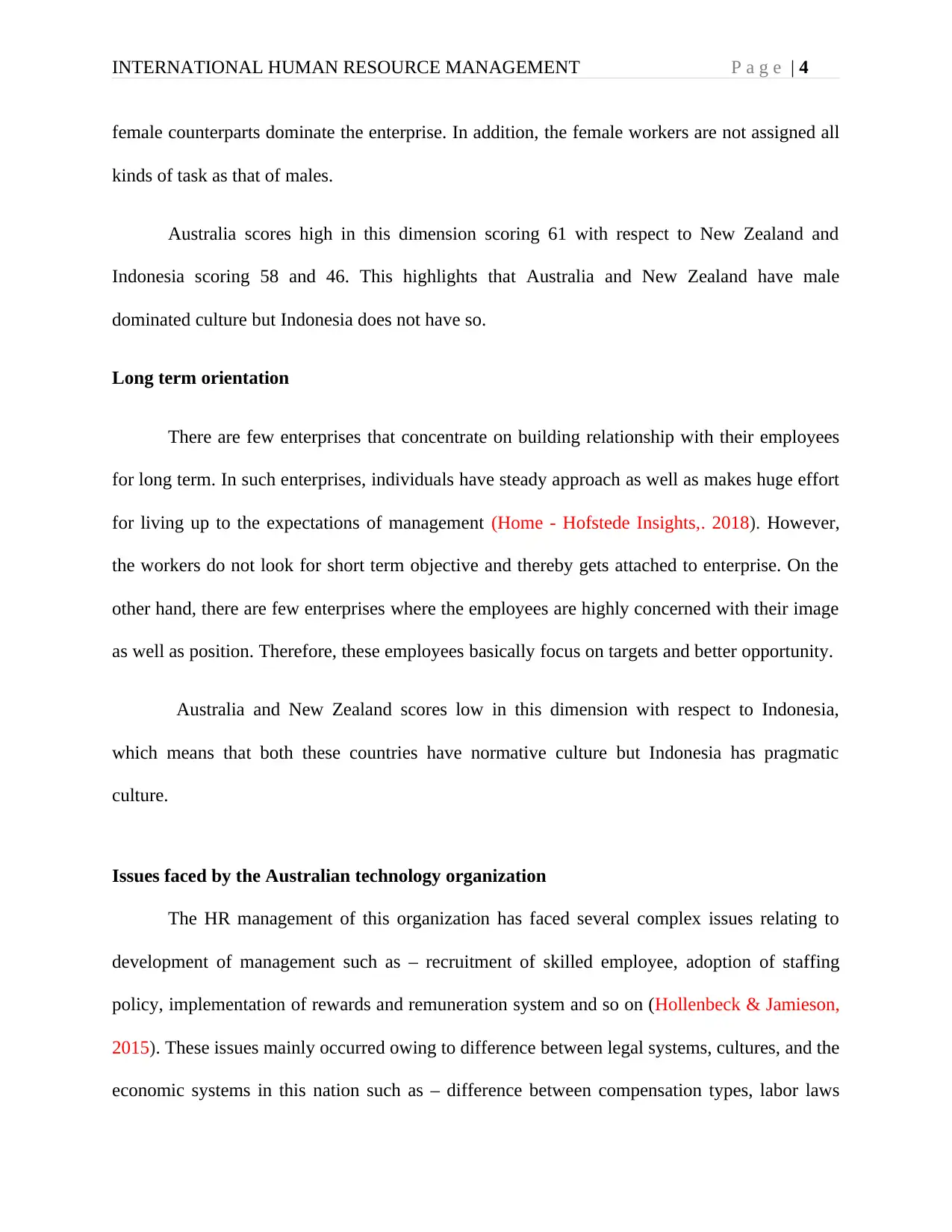
INTERNATIONAL HUMAN RESOURCE MANAGEMENT P a g e | 4 e
female counterparts dominate the enterprise. In addition, the female workers are not assigned all
kinds of task as that of males.
Australia scores high in this dimension scoring 61 with respect to New Zealand and
Indonesia scoring 58 and 46. This highlights that Australia and New Zealand have male
dominated culture but Indonesia does not have so.
Long term orientation
There are few enterprises that concentrate on building relationship with their employees
for long term. In such enterprises, individuals have steady approach as well as makes huge effort
for living up to the expectations of management (Home - Hofstede Insights,. 2018). However,
the workers do not look for short term objective and thereby gets attached to enterprise. On the
other hand, there are few enterprises where the employees are highly concerned with their image
as well as position. Therefore, these employees basically focus on targets and better opportunity.
Australia and New Zealand scores low in this dimension with respect to Indonesia,
which means that both these countries have normative culture but Indonesia has pragmatic
culture.
Issues faced by the Australian technology organization
The HR management of this organization has faced several complex issues relating to
development of management such as – recruitment of skilled employee, adoption of staffing
policy, implementation of rewards and remuneration system and so on (Hollenbeck & Jamieson,
2015). These issues mainly occurred owing to difference between legal systems, cultures, and the
economic systems in this nation such as – difference between compensation types, labor laws
female counterparts dominate the enterprise. In addition, the female workers are not assigned all
kinds of task as that of males.
Australia scores high in this dimension scoring 61 with respect to New Zealand and
Indonesia scoring 58 and 46. This highlights that Australia and New Zealand have male
dominated culture but Indonesia does not have so.
Long term orientation
There are few enterprises that concentrate on building relationship with their employees
for long term. In such enterprises, individuals have steady approach as well as makes huge effort
for living up to the expectations of management (Home - Hofstede Insights,. 2018). However,
the workers do not look for short term objective and thereby gets attached to enterprise. On the
other hand, there are few enterprises where the employees are highly concerned with their image
as well as position. Therefore, these employees basically focus on targets and better opportunity.
Australia and New Zealand scores low in this dimension with respect to Indonesia,
which means that both these countries have normative culture but Indonesia has pragmatic
culture.
Issues faced by the Australian technology organization
The HR management of this organization has faced several complex issues relating to
development of management such as – recruitment of skilled employee, adoption of staffing
policy, implementation of rewards and remuneration system and so on (Hollenbeck & Jamieson,
2015). These issues mainly occurred owing to difference between legal systems, cultures, and the
economic systems in this nation such as – difference between compensation types, labor laws
Paraphrase This Document
Need a fresh take? Get an instant paraphrase of this document with our AI Paraphraser
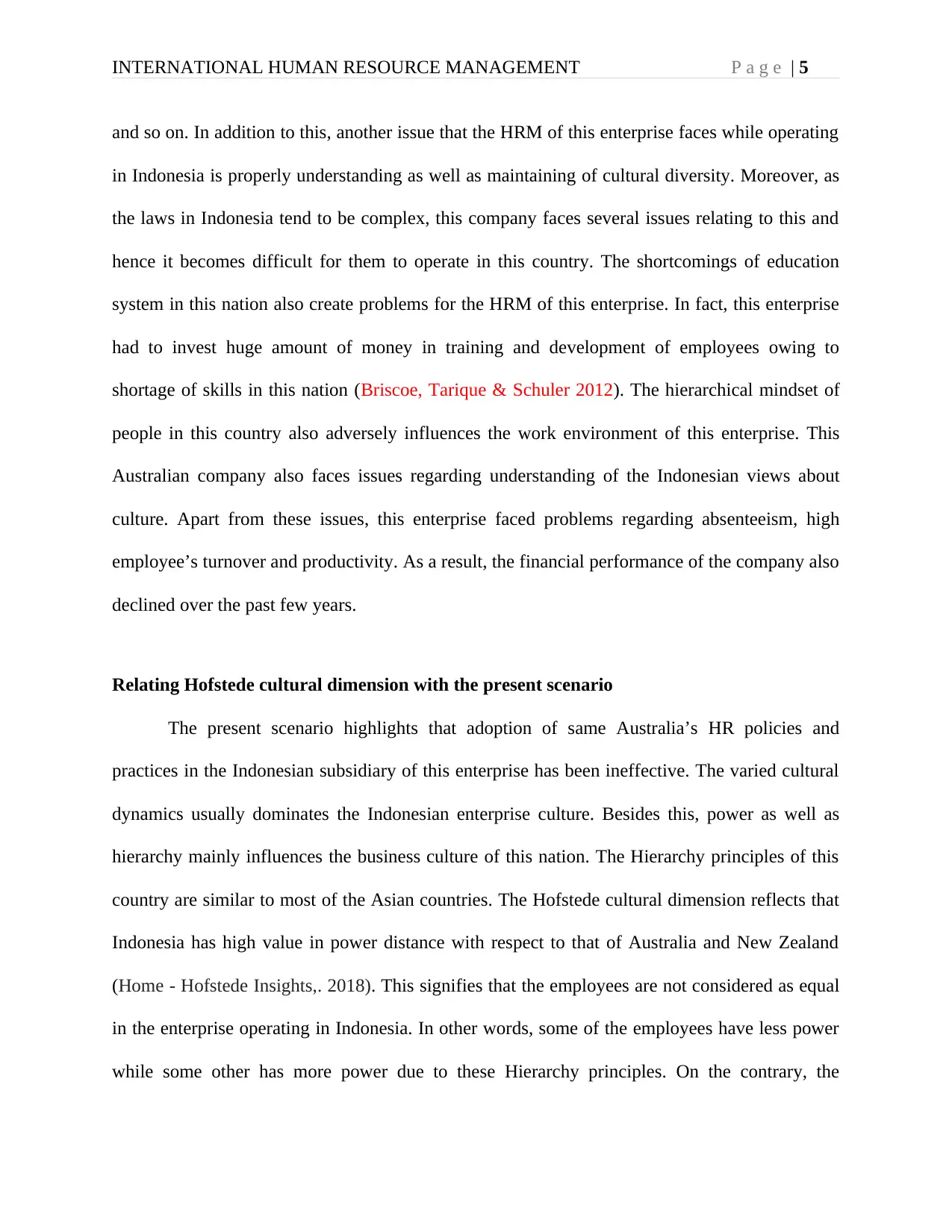
INTERNATIONAL HUMAN RESOURCE MANAGEMENT P a g e | 5 e
and so on. In addition to this, another issue that the HRM of this enterprise faces while operating
in Indonesia is properly understanding as well as maintaining of cultural diversity. Moreover, as
the laws in Indonesia tend to be complex, this company faces several issues relating to this and
hence it becomes difficult for them to operate in this country. The shortcomings of education
system in this nation also create problems for the HRM of this enterprise. In fact, this enterprise
had to invest huge amount of money in training and development of employees owing to
shortage of skills in this nation (Briscoe, Tarique & Schuler 2012). The hierarchical mindset of
people in this country also adversely influences the work environment of this enterprise. This
Australian company also faces issues regarding understanding of the Indonesian views about
culture. Apart from these issues, this enterprise faced problems regarding absenteeism, high
employee’s turnover and productivity. As a result, the financial performance of the company also
declined over the past few years.
Relating Hofstede cultural dimension with the present scenario
The present scenario highlights that adoption of same Australia’s HR policies and
practices in the Indonesian subsidiary of this enterprise has been ineffective. The varied cultural
dynamics usually dominates the Indonesian enterprise culture. Besides this, power as well as
hierarchy mainly influences the business culture of this nation. The Hierarchy principles of this
country are similar to most of the Asian countries. The Hofstede cultural dimension reflects that
Indonesia has high value in power distance with respect to that of Australia and New Zealand
(Home - Hofstede Insights,. 2018). This signifies that the employees are not considered as equal
in the enterprise operating in Indonesia. In other words, some of the employees have less power
while some other has more power due to these Hierarchy principles. On the contrary, the
and so on. In addition to this, another issue that the HRM of this enterprise faces while operating
in Indonesia is properly understanding as well as maintaining of cultural diversity. Moreover, as
the laws in Indonesia tend to be complex, this company faces several issues relating to this and
hence it becomes difficult for them to operate in this country. The shortcomings of education
system in this nation also create problems for the HRM of this enterprise. In fact, this enterprise
had to invest huge amount of money in training and development of employees owing to
shortage of skills in this nation (Briscoe, Tarique & Schuler 2012). The hierarchical mindset of
people in this country also adversely influences the work environment of this enterprise. This
Australian company also faces issues regarding understanding of the Indonesian views about
culture. Apart from these issues, this enterprise faced problems regarding absenteeism, high
employee’s turnover and productivity. As a result, the financial performance of the company also
declined over the past few years.
Relating Hofstede cultural dimension with the present scenario
The present scenario highlights that adoption of same Australia’s HR policies and
practices in the Indonesian subsidiary of this enterprise has been ineffective. The varied cultural
dynamics usually dominates the Indonesian enterprise culture. Besides this, power as well as
hierarchy mainly influences the business culture of this nation. The Hierarchy principles of this
country are similar to most of the Asian countries. The Hofstede cultural dimension reflects that
Indonesia has high value in power distance with respect to that of Australia and New Zealand
(Home - Hofstede Insights,. 2018). This signifies that the employees are not considered as equal
in the enterprise operating in Indonesia. In other words, some of the employees have less power
while some other has more power due to these Hierarchy principles. On the contrary, the
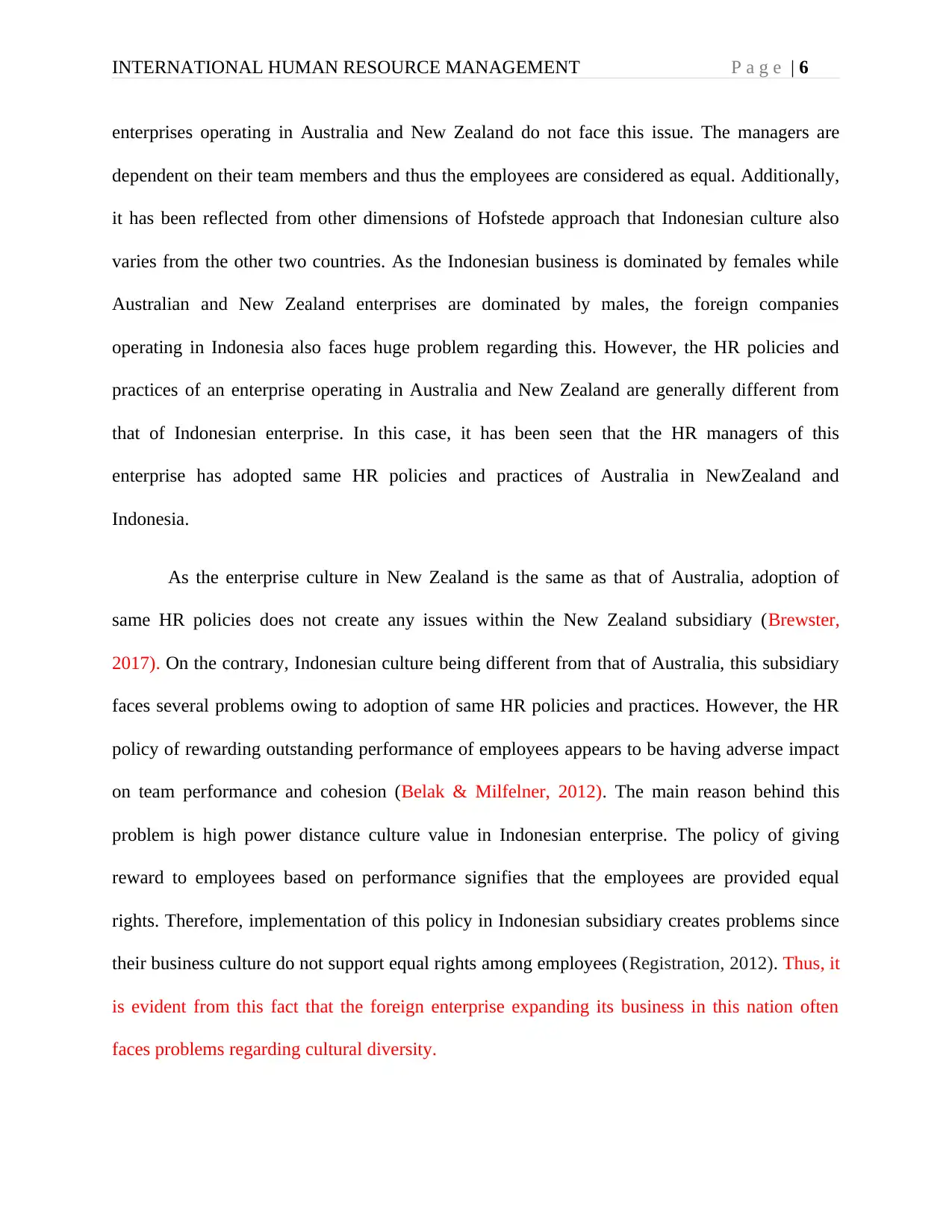
INTERNATIONAL HUMAN RESOURCE MANAGEMENT P a g e | 6 e
enterprises operating in Australia and New Zealand do not face this issue. The managers are
dependent on their team members and thus the employees are considered as equal. Additionally,
it has been reflected from other dimensions of Hofstede approach that Indonesian culture also
varies from the other two countries. As the Indonesian business is dominated by females while
Australian and New Zealand enterprises are dominated by males, the foreign companies
operating in Indonesia also faces huge problem regarding this. However, the HR policies and
practices of an enterprise operating in Australia and New Zealand are generally different from
that of Indonesian enterprise. In this case, it has been seen that the HR managers of this
enterprise has adopted same HR policies and practices of Australia in NewZealand and
Indonesia.
As the enterprise culture in New Zealand is the same as that of Australia, adoption of
same HR policies does not create any issues within the New Zealand subsidiary (Brewster,
2017). On the contrary, Indonesian culture being different from that of Australia, this subsidiary
faces several problems owing to adoption of same HR policies and practices. However, the HR
policy of rewarding outstanding performance of employees appears to be having adverse impact
on team performance and cohesion (Belak & Milfelner, 2012). The main reason behind this
problem is high power distance culture value in Indonesian enterprise. The policy of giving
reward to employees based on performance signifies that the employees are provided equal
rights. Therefore, implementation of this policy in Indonesian subsidiary creates problems since
their business culture do not support equal rights among employees (Registration, 2012). Thus, it
is evident from this fact that the foreign enterprise expanding its business in this nation often
faces problems regarding cultural diversity.
enterprises operating in Australia and New Zealand do not face this issue. The managers are
dependent on their team members and thus the employees are considered as equal. Additionally,
it has been reflected from other dimensions of Hofstede approach that Indonesian culture also
varies from the other two countries. As the Indonesian business is dominated by females while
Australian and New Zealand enterprises are dominated by males, the foreign companies
operating in Indonesia also faces huge problem regarding this. However, the HR policies and
practices of an enterprise operating in Australia and New Zealand are generally different from
that of Indonesian enterprise. In this case, it has been seen that the HR managers of this
enterprise has adopted same HR policies and practices of Australia in NewZealand and
Indonesia.
As the enterprise culture in New Zealand is the same as that of Australia, adoption of
same HR policies does not create any issues within the New Zealand subsidiary (Brewster,
2017). On the contrary, Indonesian culture being different from that of Australia, this subsidiary
faces several problems owing to adoption of same HR policies and practices. However, the HR
policy of rewarding outstanding performance of employees appears to be having adverse impact
on team performance and cohesion (Belak & Milfelner, 2012). The main reason behind this
problem is high power distance culture value in Indonesian enterprise. The policy of giving
reward to employees based on performance signifies that the employees are provided equal
rights. Therefore, implementation of this policy in Indonesian subsidiary creates problems since
their business culture do not support equal rights among employees (Registration, 2012). Thus, it
is evident from this fact that the foreign enterprise expanding its business in this nation often
faces problems regarding cultural diversity.
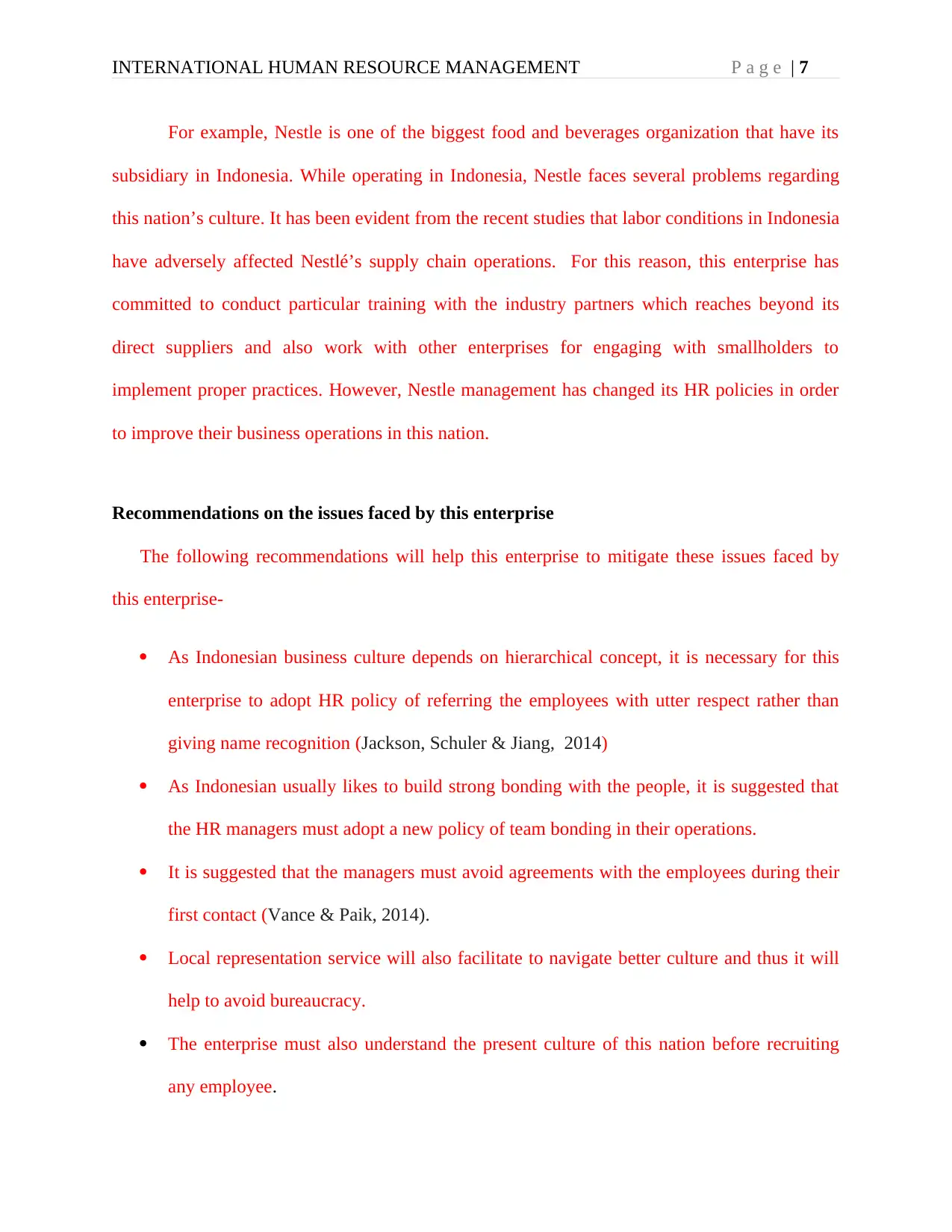
INTERNATIONAL HUMAN RESOURCE MANAGEMENT P a g e | 7 e
For example, Nestle is one of the biggest food and beverages organization that have its
subsidiary in Indonesia. While operating in Indonesia, Nestle faces several problems regarding
this nation’s culture. It has been evident from the recent studies that labor conditions in Indonesia
have adversely affected Nestlé’s supply chain operations. For this reason, this enterprise has
committed to conduct particular training with the industry partners which reaches beyond its
direct suppliers and also work with other enterprises for engaging with smallholders to
implement proper practices. However, Nestle management has changed its HR policies in order
to improve their business operations in this nation.
Recommendations on the issues faced by this enterprise
The following recommendations will help this enterprise to mitigate these issues faced by
this enterprise-
As Indonesian business culture depends on hierarchical concept, it is necessary for this
enterprise to adopt HR policy of referring the employees with utter respect rather than
giving name recognition (Jackson, Schuler & Jiang, 2014)
As Indonesian usually likes to build strong bonding with the people, it is suggested that
the HR managers must adopt a new policy of team bonding in their operations.
It is suggested that the managers must avoid agreements with the employees during their
first contact (Vance & Paik, 2014).
Local representation service will also facilitate to navigate better culture and thus it will
help to avoid bureaucracy.
The enterprise must also understand the present culture of this nation before recruiting
any employee.
For example, Nestle is one of the biggest food and beverages organization that have its
subsidiary in Indonesia. While operating in Indonesia, Nestle faces several problems regarding
this nation’s culture. It has been evident from the recent studies that labor conditions in Indonesia
have adversely affected Nestlé’s supply chain operations. For this reason, this enterprise has
committed to conduct particular training with the industry partners which reaches beyond its
direct suppliers and also work with other enterprises for engaging with smallholders to
implement proper practices. However, Nestle management has changed its HR policies in order
to improve their business operations in this nation.
Recommendations on the issues faced by this enterprise
The following recommendations will help this enterprise to mitigate these issues faced by
this enterprise-
As Indonesian business culture depends on hierarchical concept, it is necessary for this
enterprise to adopt HR policy of referring the employees with utter respect rather than
giving name recognition (Jackson, Schuler & Jiang, 2014)
As Indonesian usually likes to build strong bonding with the people, it is suggested that
the HR managers must adopt a new policy of team bonding in their operations.
It is suggested that the managers must avoid agreements with the employees during their
first contact (Vance & Paik, 2014).
Local representation service will also facilitate to navigate better culture and thus it will
help to avoid bureaucracy.
The enterprise must also understand the present culture of this nation before recruiting
any employee.
Secure Best Marks with AI Grader
Need help grading? Try our AI Grader for instant feedback on your assignments.
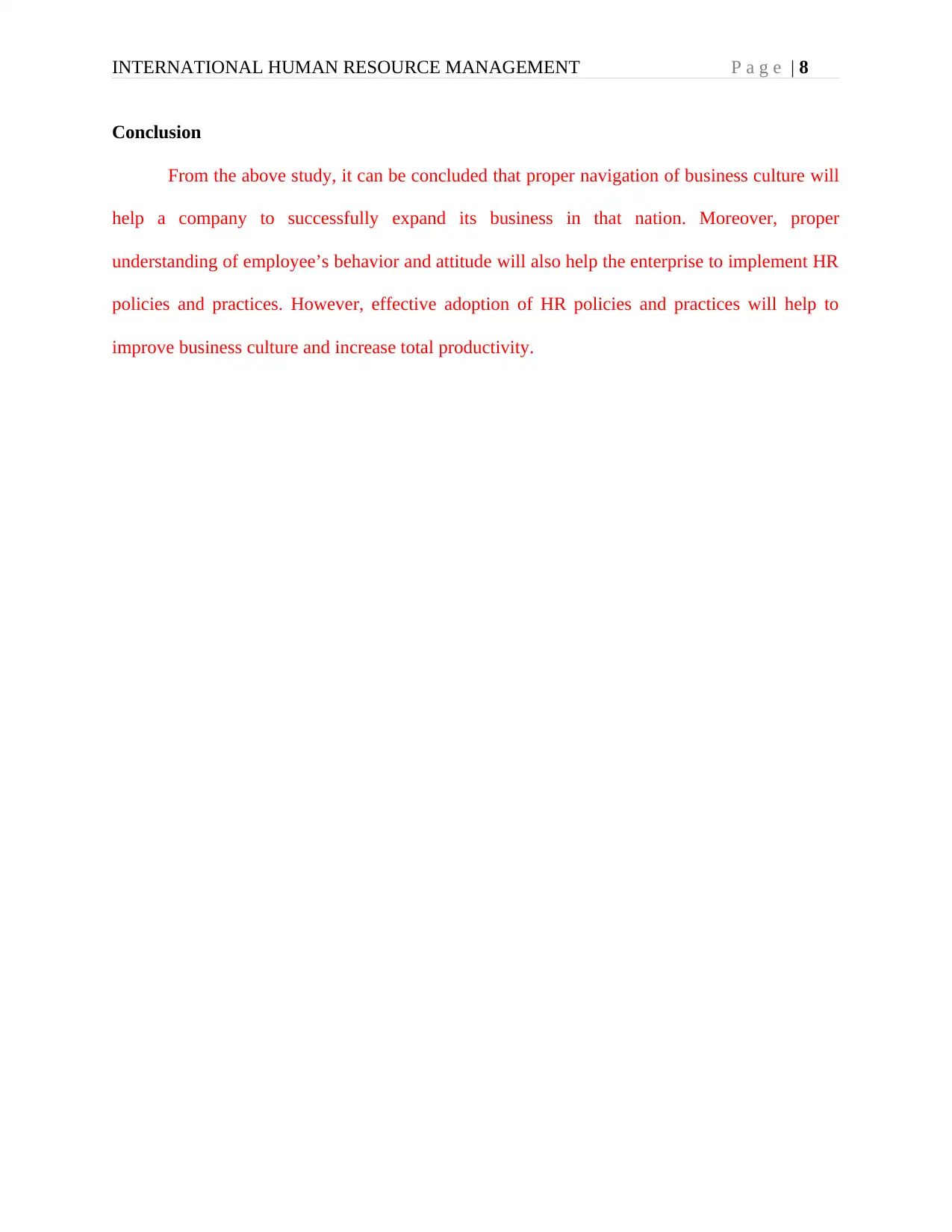
INTERNATIONAL HUMAN RESOURCE MANAGEMENT P a g e | 8 e
Conclusion
From the above study, it can be concluded that proper navigation of business culture will
help a company to successfully expand its business in that nation. Moreover, proper
understanding of employee’s behavior and attitude will also help the enterprise to implement HR
policies and practices. However, effective adoption of HR policies and practices will help to
improve business culture and increase total productivity.
Conclusion
From the above study, it can be concluded that proper navigation of business culture will
help a company to successfully expand its business in that nation. Moreover, proper
understanding of employee’s behavior and attitude will also help the enterprise to implement HR
policies and practices. However, effective adoption of HR policies and practices will help to
improve business culture and increase total productivity.
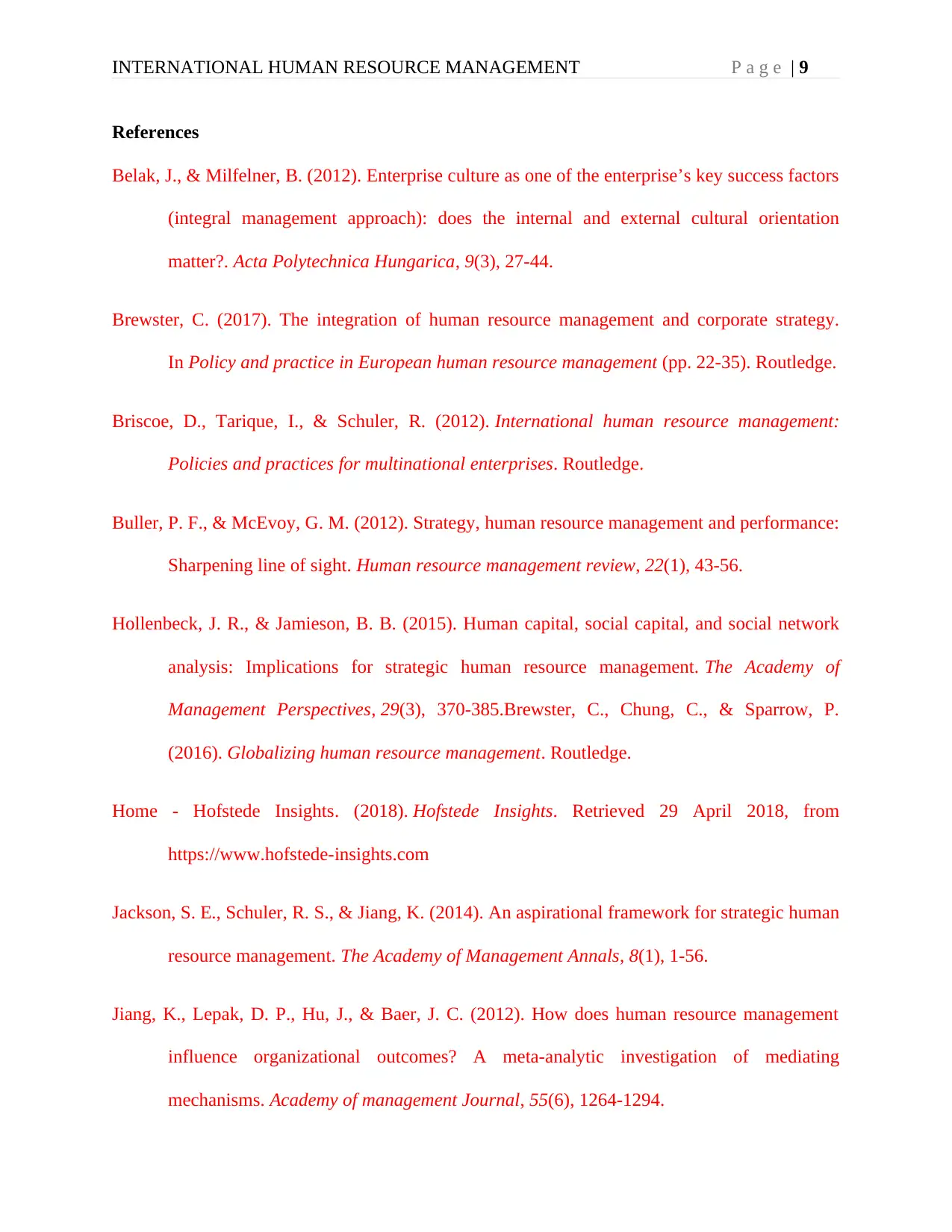
INTERNATIONAL HUMAN RESOURCE MANAGEMENT P a g e | 9 e
References
Belak, J., & Milfelner, B. (2012). Enterprise culture as one of the enterprise’s key success factors
(integral management approach): does the internal and external cultural orientation
matter?. Acta Polytechnica Hungarica, 9(3), 27-44.
Brewster, C. (2017). The integration of human resource management and corporate strategy.
In Policy and practice in European human resource management (pp. 22-35). Routledge.
Briscoe, D., Tarique, I., & Schuler, R. (2012). International human resource management:
Policies and practices for multinational enterprises. Routledge.
Buller, P. F., & McEvoy, G. M. (2012). Strategy, human resource management and performance:
Sharpening line of sight. Human resource management review, 22(1), 43-56.
Hollenbeck, J. R., & Jamieson, B. B. (2015). Human capital, social capital, and social network
analysis: Implications for strategic human resource management. The Academy of
Management Perspectives, 29(3), 370-385.Brewster, C., Chung, C., & Sparrow, P.
(2016). Globalizing human resource management. Routledge.
Home - Hofstede Insights. (2018). Hofstede Insights. Retrieved 29 April 2018, from
https://www.hofstede-insights.com
Jackson, S. E., Schuler, R. S., & Jiang, K. (2014). An aspirational framework for strategic human
resource management. The Academy of Management Annals, 8(1), 1-56.
Jiang, K., Lepak, D. P., Hu, J., & Baer, J. C. (2012). How does human resource management
influence organizational outcomes? A meta-analytic investigation of mediating
mechanisms. Academy of management Journal, 55(6), 1264-1294.
References
Belak, J., & Milfelner, B. (2012). Enterprise culture as one of the enterprise’s key success factors
(integral management approach): does the internal and external cultural orientation
matter?. Acta Polytechnica Hungarica, 9(3), 27-44.
Brewster, C. (2017). The integration of human resource management and corporate strategy.
In Policy and practice in European human resource management (pp. 22-35). Routledge.
Briscoe, D., Tarique, I., & Schuler, R. (2012). International human resource management:
Policies and practices for multinational enterprises. Routledge.
Buller, P. F., & McEvoy, G. M. (2012). Strategy, human resource management and performance:
Sharpening line of sight. Human resource management review, 22(1), 43-56.
Hollenbeck, J. R., & Jamieson, B. B. (2015). Human capital, social capital, and social network
analysis: Implications for strategic human resource management. The Academy of
Management Perspectives, 29(3), 370-385.Brewster, C., Chung, C., & Sparrow, P.
(2016). Globalizing human resource management. Routledge.
Home - Hofstede Insights. (2018). Hofstede Insights. Retrieved 29 April 2018, from
https://www.hofstede-insights.com
Jackson, S. E., Schuler, R. S., & Jiang, K. (2014). An aspirational framework for strategic human
resource management. The Academy of Management Annals, 8(1), 1-56.
Jiang, K., Lepak, D. P., Hu, J., & Baer, J. C. (2012). How does human resource management
influence organizational outcomes? A meta-analytic investigation of mediating
mechanisms. Academy of management Journal, 55(6), 1264-1294.
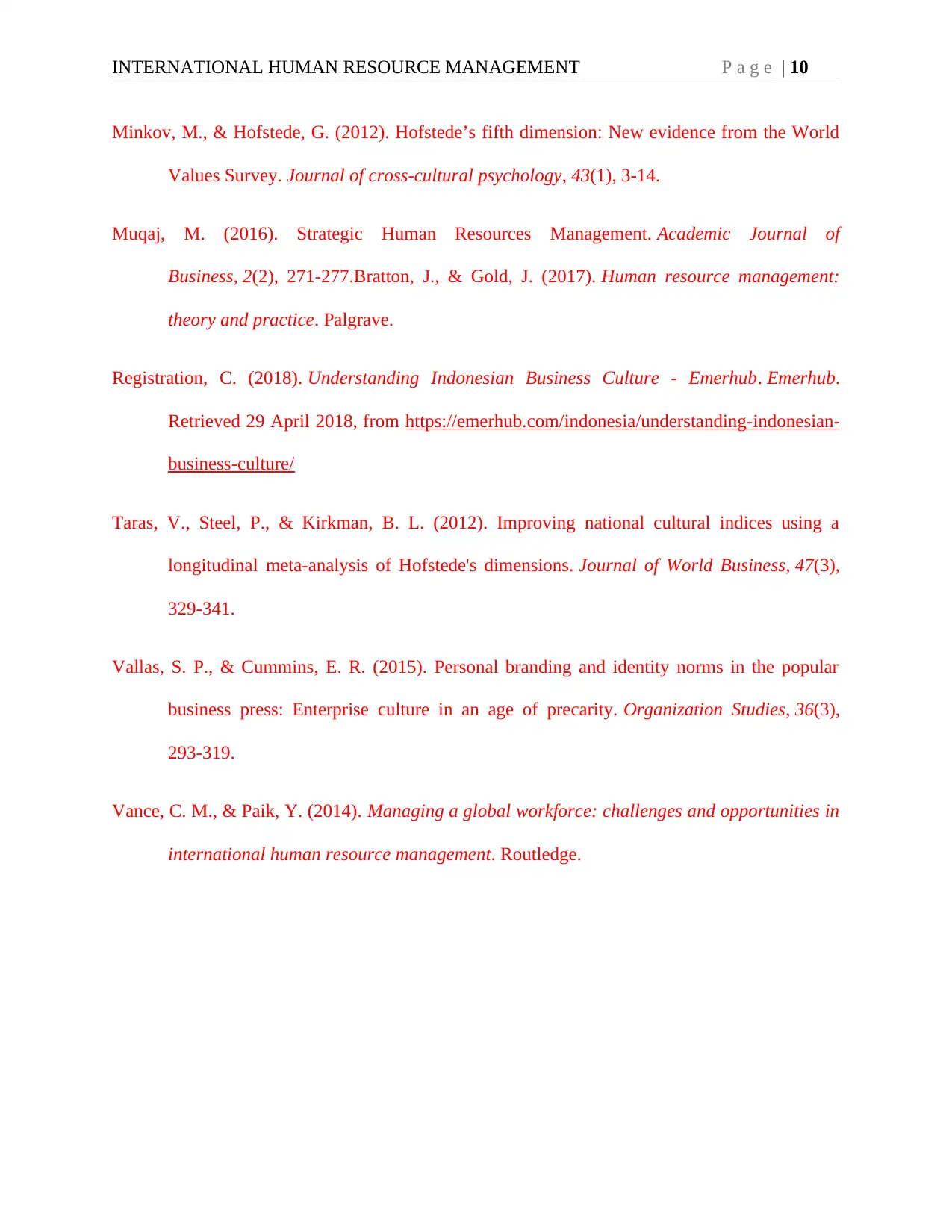
INTERNATIONAL HUMAN RESOURCE MANAGEMENT P a g e | 10 e
Minkov, M., & Hofstede, G. (2012). Hofstede’s fifth dimension: New evidence from the World
Values Survey. Journal of cross-cultural psychology, 43(1), 3-14.
Muqaj, M. (2016). Strategic Human Resources Management. Academic Journal of
Business, 2(2), 271-277.Bratton, J., & Gold, J. (2017). Human resource management:
theory and practice. Palgrave.
Registration, C. (2018). Understanding Indonesian Business Culture - Emerhub. Emerhub.
Retrieved 29 April 2018, from https://emerhub.com/indonesia/understanding-indonesian-
business-culture/
Taras, V., Steel, P., & Kirkman, B. L. (2012). Improving national cultural indices using a
longitudinal meta-analysis of Hofstede's dimensions. Journal of World Business, 47(3),
329-341.
Vallas, S. P., & Cummins, E. R. (2015). Personal branding and identity norms in the popular
business press: Enterprise culture in an age of precarity. Organization Studies, 36(3),
293-319.
Vance, C. M., & Paik, Y. (2014). Managing a global workforce: challenges and opportunities in
international human resource management. Routledge.
Minkov, M., & Hofstede, G. (2012). Hofstede’s fifth dimension: New evidence from the World
Values Survey. Journal of cross-cultural psychology, 43(1), 3-14.
Muqaj, M. (2016). Strategic Human Resources Management. Academic Journal of
Business, 2(2), 271-277.Bratton, J., & Gold, J. (2017). Human resource management:
theory and practice. Palgrave.
Registration, C. (2018). Understanding Indonesian Business Culture - Emerhub. Emerhub.
Retrieved 29 April 2018, from https://emerhub.com/indonesia/understanding-indonesian-
business-culture/
Taras, V., Steel, P., & Kirkman, B. L. (2012). Improving national cultural indices using a
longitudinal meta-analysis of Hofstede's dimensions. Journal of World Business, 47(3),
329-341.
Vallas, S. P., & Cummins, E. R. (2015). Personal branding and identity norms in the popular
business press: Enterprise culture in an age of precarity. Organization Studies, 36(3),
293-319.
Vance, C. M., & Paik, Y. (2014). Managing a global workforce: challenges and opportunities in
international human resource management. Routledge.
1 out of 13
Related Documents
Your All-in-One AI-Powered Toolkit for Academic Success.
+13062052269
info@desklib.com
Available 24*7 on WhatsApp / Email
![[object Object]](/_next/static/media/star-bottom.7253800d.svg)
Unlock your academic potential
© 2024 | Zucol Services PVT LTD | All rights reserved.





